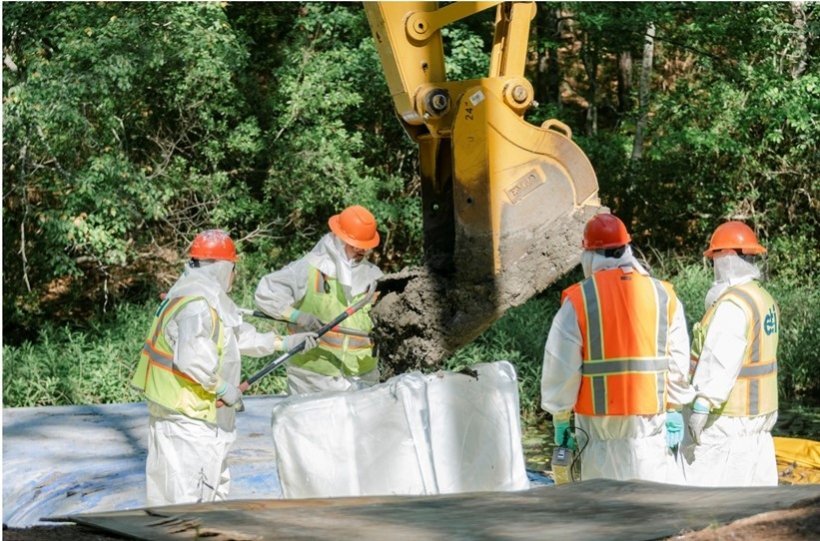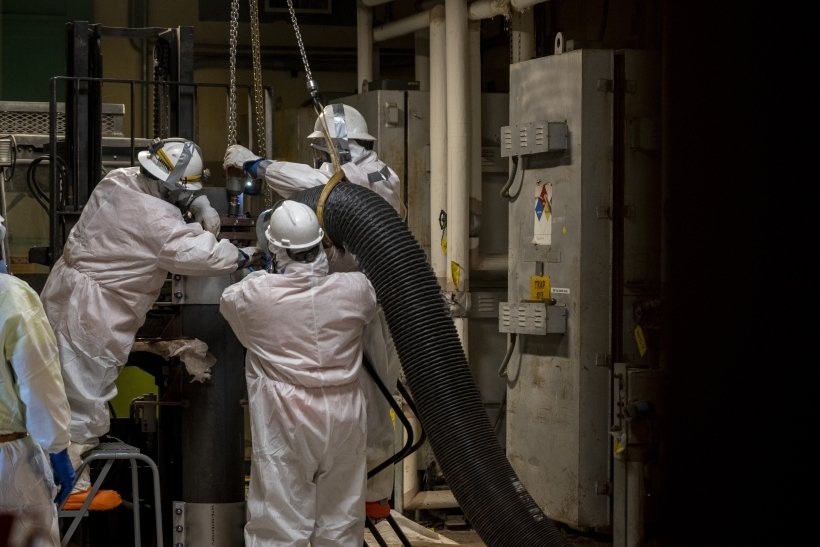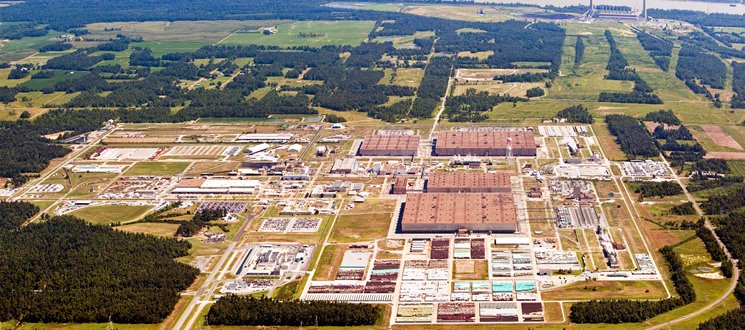Workers remove contaminated sediment from the SRS in South Carolina. A $19 million DOE grant will support state monitoring of the site. (Photo: DOE)
The Department of Energy’s Office of Environmental Management has awarded nearly $54 million in noncompetitive financial assistance grants and cooperative agreements to help support the office’s cleanup program. DOE-EM is responsible for environmental legacy cleanup of the effects of decades of nuclear weapons development and government-sponsored nuclear energy research.
A West Valley ancillary support building is demolished in 2018. (Photo: DOE/CH2M Hill–BWXT West Valley)
The Department of Energy’s Office of Environmental Management has issued a draft request for proposal for a contract covering the next phase of cleanup at the West Valley Demonstration Project in western New York.
An elk herd at the DOE’s Hanford Site in Washington state. (Photo: DOE)
The Department of Energy has released the first request for information (RFI) related to the department’s Cleanup to Clean Energy initiative, which aims to repurpose certain DOE-owned lands, portions of which were previously used in the nation’s nuclear weapons program, into sites for clean energy generation.
The DOE-EM–Sandia team and Sellafield representatives pose with Spot Robot at the Sellafield Engineering and Maintenance Centre of Excellence. (Photo: DOE)
Robotics experts from Sandia National Laboratories and representatives from the Department of Energy Office of Environmental Management’s Technology Development Office recently visited the Sellafield nuclear site in England to discuss how robotics, artificial intelligence, and other emerging tools can be developed and used in nuclear cleanup operations.
The Alpha-2 building at Y-12 in Oak Ridge is a former uranium enrichment facility that dates to the Manhattan Project era. (Photo: DOE)
The Department of Energy’s Office of Environmental Management said that crews have completed major deactivation efforts at the Alpha-2 building at the Y-12 National Security Complex in Oak Ridge, Tenn. The former uranium enrichment facility is scheduled for demolition next year.
A 300-pound bag of frit is in position to be poured into the melter at Hanford’s LAW Facility. (Photo: Bechtel National)
The Department of Energy’s Office of Environmental Management announced that the first batches of glass-forming beads, called frit, were poured last week into a melter at the Hanford Site’s Waste Treatment and Immobilization Plant (WTP), also known as the Vit Plant. The melter, which has been heated to 2,100ºF, will be used to immobilize Hanford’s radioactive and chemical tank waste, turning it into a stable glass form through vitrification.
Work crews use light construction equipment to remove the final pieces of asphalt from one of the pads at the TSA-RE at INL. (Photo: DOE)
The Idaho National Laboratory is moving closer toward closing its largest building—which, at more than 316,000 square feet, could comfortably house a modern U.S. aircraft carrier, according to the Department of Energy.
Savannah River National Laboratory employee Vernon Bush, center, and SRNL summer intern Jadrion Huell, standing at right, of Claflin University, conduct a job shadowing activity with students Tredarius Lassiter, seated at left, and Tommy Applewhite. (Photo: DOE)
A three-day Minority Serving Institutions Partnership Program (MSIPP) event, led by Savannah River National Laboratory researcher Simona Hunyadi Murph, was held recently at the South Carolina site, according to a release by the Department of Energy’s Office of Environmental Management (DOE-EM). The event included a collaborative workshop, job shadowing, and a tour of the laboratory and Savannah River Site field activities.
Portsmouth’s X-326 Process Building undergoes demolition in 2022. (Photo: DOE)
The Department of Energy’s Office of Environmental Management awarded a 10-year contract worth up to $5.87 billion to Southern Ohio Cleanup Company (SOCCo) of Aiken, S.C., for the decontamination and decommissioning of the DOE’s Portsmouth site in southern Ohio. SOCCo is a newly formed limited liability company comprising Amentum Environment and Energy, Fluor Federal Services, and Cavendish Nuclear (USA) Inc.
Paducah Site deactivation crews use negative air machines to open sodium fluoride traps. (Photo: DOE)
The Department of Energy’s Office of Environmental Management recently shipped for off-site disposal 14 sodium fluoride traps, or exchange vessels, from the C-310 Product Withdrawal facility at the DOE’s Paducah Gaseous Diffusion Plant site in Kentucky. DOE-EM said it has also eliminated the site’s entire inventory of chlorine gas cylinders.
The Waste Isolation Pilot Plant, near Carlsbad, N.M. (Photo: DOE)
The Department of Energy’s Office of Environmental Management and the New Mexico Environment Department (NMED) have negotiated a settlement on terms to renew the 10-year operating permit for the Waste Isolation Pilot Plant near Carlsbad, N.M. The DOE, along with WIPP’s operating contractor, Salado Isolation Mining Contractors, and the NMED negotiated the settlement with New Mexico stakeholders.
The Paducah site. (Photo: DOE)
The Department of Energy’s Office of Environmental Management has awarded a $2 million grant to the Paducah Area Chamber of Commerce for its work in considering the possible future uses of the Paducah Gaseous Diffusion Plant site in Kentucky. The project will consist of site mapping, community studies, data analysis, and development of recommended strategies.
DOE-EM’s Greg Sosson (standing) views Integrated Waste Treatment activity during the facility’s first day of radiological operations. (Photo: DOE)
After initial runs using a mix of radiological waste and nonradioactive simulant, the Integrated Waste Treatment Unit (IWTU) at the Idaho National Laboratory site has progressed to treating sodium-bearing waste entirely, the Department of Energy’s Office of Environmental Management (DOE-EM) announced on May 22.
DOE-EM officials, IWTU employees, and others signed the first stainless steel canister prior to crews filling it with sodium-bearing waste and simulant. Once filled, that canister and 15 others were placed in a concrete vault for storage. (Photo: DOE)
Since the launch of operations just over a month ago, the Integrated Waste Treatment Unit (IWTU) at Idaho National Laboratory has increased sodium-bearing waste treatment fivefold. This activity is a vital step in removing the remaining liquid waste from nearby underground tanks at the site and protecting the underlying Snake River Plain Aquifer.
A CAST Specialty Transportation truck delivering TRU waste packages to WIPP. (Photo: DOE)
The Department of Energy’s Waste Isolation Pilot Plant (WIPP) recently marked a milestone after its drivers exceeded 16 million safe miles without a serious accident or injury—equivalent to 33 round trips to the moon or more than 642 trips around the world, the DOE’s Office of Environmental Management announced.














